Reference Gene U2 Enables Direct Comparison between Relative Gene Expression Levels of Vascular Smooth Muscle Cells in Tissue and Culture Using Real-Time Quantitative PCR
Abstract
:1. Introduction
1.1. Relevance and Aim of This Study
1.2. Quantitative PCR
1.3. RGs and Their Requirements for Relative Gene Expression Quantification
1.4. Aortic vSMCs and Cell Culture
2. Materials and Methods
2.1. Animals
2.2. Tissue Preparation
2.3. Histology-Paraffin Sectioning and Azan Staining
2.4. Immunofluorescence (IF) Staining of Paraffin-Embedded Tissue Sections
2.5. Immunohistochemistry (IHC) of Paraffin-Embedded Tissue Sections
2.6. vSMC Extraction
2.7. Primary vSMC Culture
2.8. IF Staining of vSMCs
2.9. RNA Isolation
2.10. cDNA Synthesis
2.11. Primer Search for Potential RGs
2.12. qPCR Primers and Calculation of Primer Efficiency
2.13. qPCR
2.14. Statistics
3. Results and Discussion
3.1. Characterisation of Isolated and Cultured vSMCs
3.2. Expression Levels of Routinely Used RGs Differ Significantly between Aortic vSMCs in Culture and Intact Media
3.3. Identification of U2 as an RG Enabling a Direct Comparison of vSMCs in Intact Media and Culture
4. Conclusions and Outlook
Author Contributions
Funding
Institutional Review Board Statement
Acknowledgments
Conflicts of Interest
Appendix A

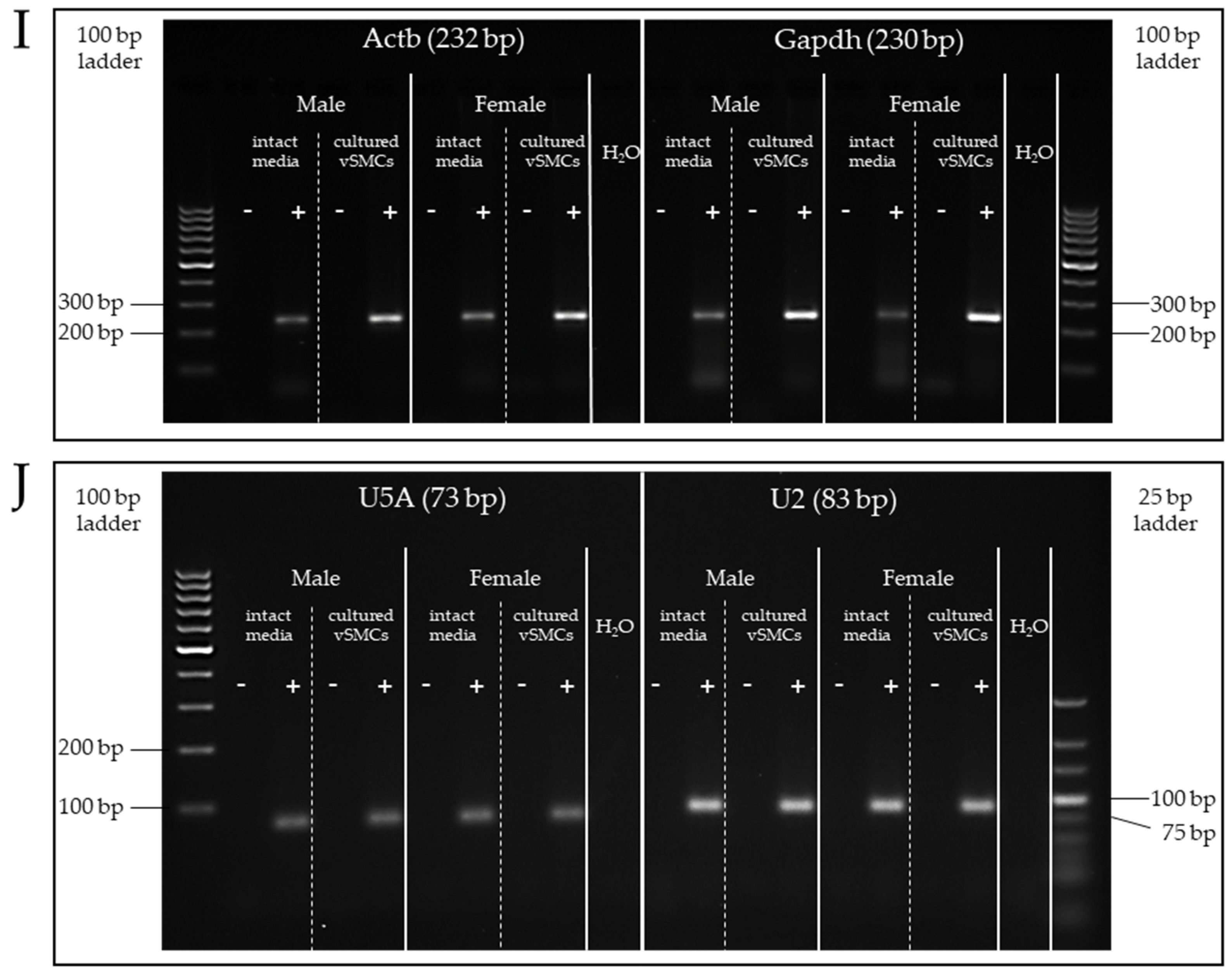

References
- Al-Lamki, R.S.; Bradley, J.R.; Pober, J.S. Human organ culture: Updating the approach to bridge the gap from in vitro to in vivo in inflammation, Cancer, and Stem Cell Biology. Front. Med. 2017, 4, 148. [Google Scholar] [CrossRef] [PubMed]
- Worth, N.F.; Rolfe, B.E.; Song, J.; Campbell, G.R. Vascular smooth muscle cell phenotypic modulation in culture is associated with reorganisation of contractile and cytoskeletal proteins. Cell Motil. Cytoskelet. 2001, 49, 130–145. [Google Scholar] [CrossRef]
- Qiu, J.; Zheng, Y.; Hu, J.; Liao, D.; Gregersen, H.; Deng, X.; Fan, Y.; Wang, G. Biomechanical regulation of vascular smooth muscle cell functions: From in vitro to in vivo understanding. J. R. Soc. Interface 2014, 11, 20130852. [Google Scholar] [CrossRef]
- Pedroza, A.J.; Tashima, Y.; Shad, R.; Cheng, P.; Wirka, R.; Churovich, S.; Nakamura, K.; Yokoyama, N.; Cui, J.Z.; Iosef, C.; et al. Single-cell transcriptomic profiling of vascular smooth muscle cell phenotype modulation in marfan syndrome Aortic Aneurysm. Arterioscler. Thromb. Vasc. Biol. 2020, 40, 2195–2211. [Google Scholar] [CrossRef] [PubMed]
- Rameshrad, M.; Babaei, H.; Azarmi, Y.; Fouladi, D.F. Rat aorta as a pharmacological tool for in vitro and in vivo studies. Life Sci. 2016, 145, 190–204. [Google Scholar] [CrossRef] [PubMed]
- Livak, K.J.; Schmittgen, T.D. Analysis of relative gene expression data using real-time quantitative PCR and the 2−ΔΔCT Method. Methods 2001, 25, 402–408. [Google Scholar] [CrossRef]
- Morrison, T.B.; Weis, J.J.; Wittwer, C.T. Quantification of low-copy transcripts by continuous SYBR Green I monitoring during amplification. Biotechniques 1998, 24, 954–958, 960, 962. [Google Scholar]
- Pfaffl, M.W. A new mathematical model for relative quantification in real-time RT–PCR. Nucleic Acids Res. 2001, 29, e45. [Google Scholar] [CrossRef]
- Li, K.; Brownley, A. Primer design for RT-PCR. Methods Mol. Biol. 2010, 630, 271–299. [Google Scholar] [CrossRef]
- Kozera, B.; Rapacz, M. Reference genes in real-time PCR. J. Appl. Genet. 2013, 54, 391–406. [Google Scholar] [CrossRef]
- Mullis, K.; Faloona, F.; Scharf, S.; Saiki, R.; Horn, G.; Erlich, H. Specific enzymatic amplification of DNA in vitro: The polymerase chain reaction. Cold Spring Harb. Symp. Quant. Biol. 1986, 51 Pt 1, 263–273. [Google Scholar] [CrossRef] [PubMed]
- Wittmeier, P.; Hummel, S. Agarose gel electrophoresis to assess PCR product yield: Comparison with spectrophotometry, fluorometry and qPCR. Biotechniques 2022, 72, 155–158. [Google Scholar] [CrossRef] [PubMed]
- Bustin, S.A.; Benes, V.; Nolan, T.; Pfaffl, M.W. Quantitative real-time RT-PCR—A perspective. J. Mol. Endocrinol. 2005, 34, 597–601. [Google Scholar] [CrossRef]
- Fleige, S.; Pfaffl, M.W. RNA integrity and the effect on the real-time qRT-PCR performance. Mol. Aspects Med. 2006, 27, 126–139. [Google Scholar] [CrossRef]
- Marten, N.W.; Burke, E.J.; Hayden, J.M.; Straus, D.S. Effect of amino acid limitation on the expression of 19 genes in rat hepatoma cells. FASEB J. 1994, 8, 538–544. [Google Scholar] [CrossRef]
- Sampilvanjil, A.; Karasawa, T.; Yamada, N.; Komada, T.; Higashi, T.; Baatarjav, C.; Watanabe, S.; Kamata, R.; Ohno, N.; Takahashi, M. Cigarette smoke extract induces ferroptosis in vascular smooth muscle cells. Am. J. Physiol. Heart Circ. Physiol. 2020, 318, H508–H518. [Google Scholar] [CrossRef]
- Torres, V.E.; Cai, Y.; Chen, X.I.; Wu, G.Q.; Geng, L.; Cleghorn, K.A.; Johnson, C.M.; Somlo, S. Vascular expression of polycystin-2. J. Am. Soc. Nephrol. 2001, 12, 1–9. [Google Scholar] [CrossRef] [PubMed]
- Hafen, B.B.; Shook, M.; Burns, B. Anatomy, Smooth Muscle. In StatPearls; StatPearls Publishing Copyright © 2023; StatPearls Publishing LLC.: Treasure Island, FL, USA, 2023. [Google Scholar]
- Rzucidlo, E.M.; Martin, K.A.; Powell, R.J. Regulation of vascular smooth muscle cell differentiation. J. Vasc. Surg. 2007, 45 (Suppl. A), A25–A32. [Google Scholar] [CrossRef]
- Lacolley, P.; Regnault, V.; Nicoletti, A.; Li, Z.; Michel, J.B. The vascular smooth muscle cell in arterial pathology: A cell that can take on multiple roles. Cardiovasc. Res. 2012, 95, 194–204. [Google Scholar] [CrossRef]
- Lehners, M.; Dobrowinski, H.; Feil, S.; Feil, R. cGMP signaling and vascular smooth muscle cell plasticity. J. Cardiovasc. Dev. Dis. 2018, 5, 20. [Google Scholar] [CrossRef]
- Huber, A.; Badylak, S.F. Phenotypic changes in cultured smooth muscle cells: Limitation or opportunity for tissue engineering of hollow organs? J. Tissue Eng. Regen. Med. 2012, 6, 505–511. [Google Scholar] [CrossRef] [PubMed]
- Méndez-Barbero, N.; Gutiérrez-Muñoz, C.; Blanco-Colio, L.M. Cellular crosstalk between endothelial and smooth muscle cells in vascular wall remodeling. Int. J. Mol. Sci. 2021, 22, 20. [Google Scholar] [CrossRef] [PubMed]
- Hortells, L.; Sosa, C.; Millán, Á.; Sorribas, V. Critical parameters of the in vitro method of vascular smooth muscle cell calcification. PLoS ONE 2015, 10, e0141751. [Google Scholar] [CrossRef]
- Owens, G.K.; Kumar, M.S.; Wamhoff, B.R. Molecular regulation of vascular smooth muscle cell differentiation in development and disease. Physiol. Rev. 2004, 84, 767–801. [Google Scholar] [CrossRef] [PubMed]
- Allahverdian, S.; Chaabane, C.; Boukais, K.; Francis, G.A.; Bochaton-Piallat, M.L. Smooth muscle cell fate and plasticity in atherosclerosis. Cardiovasc. Res. 2018, 114, 540–550. [Google Scholar] [CrossRef] [PubMed]
- Shi, J.; Yang, Y.; Cheng, A.; Xu, G.; He, F. Metabolism of vascular smooth muscle cells in vascular diseases. Am. J. Physiol. Heart Circ. Physiol. 2020, 319, H613–H631. [Google Scholar] [CrossRef]
- Jensen, L.F.; Bentzon, J.F.; Albarrán-Juárez, J. The phenotypic responses of vascular smooth muscle cells exposed to mechanical cues. Cells 2021, 10, 2209. [Google Scholar] [CrossRef]
- Davidoff, M.S.; Middendorff, R.; Mayer, B.; deVente, J.; Koesling, D.; Holstein, A.F. Nitric oxide/cGMP pathway components in the Leydig cells of the human testis. Cell Tissue Res. 1997, 287, 161–170. [Google Scholar] [CrossRef]
- Davidoff, M.S.; Middendorff, R.; Mayer, B.; Holstein, A.F. Nitric oxide synthase (NOS-I) in Leydig cells of the human testis. Arch. Histol. Cytol. 1995, 58, 17–30. [Google Scholar] [CrossRef]
- Taki, F.A.; Abdel-Rahman, A.A.; Zhang, B. A comprehensive approach to identify reliable reference gene candidates to investigate the link between alcoholism and endocrinology in Sprague-Dawley rats. PLoS ONE 2014, 9, e94311. [Google Scholar] [CrossRef]
- Owens, G.K. Regulation of differentiation of vascular smooth muscle cells. Physiol. Rev. 1995, 75, 487–517. [Google Scholar] [CrossRef] [PubMed]
- Sobue, K.; Hayashi, K.; Nishida, W. Expressional regulation of smooth muscle cell-specific genes in association with phenotypic modulation. Mol. Cell. Biochem. 1999, 190, 105–118. [Google Scholar] [CrossRef] [PubMed]
- Malorni, W.; Straface, E.; Matarrese, P.; Ascione, B.; Coinu, R.; Canu, S.; Galluzzo, P.; Marino, M.; Franconi, F. Redox state and gender differences in vascular smooth muscle cells. FEBS Lett. 2008, 582, 635–642. [Google Scholar] [CrossRef] [PubMed]
- Dehaini, H.; Fardoun, M.; Abou-Saleh, H.; El-Yazbi, A.; Eid, A.A.; Eid, A.H. Estrogen in vascular smooth muscle cells: A friend or a foe? Vascul. Pharmacol. 2018, 111, 15–21. [Google Scholar] [CrossRef]
- Regitz-Zagrosek, V.; Kararigas, G. Mechanistic pathways of sex differences in cardiovascular disease. Physiol. Rev. 2017, 97, 1–37. [Google Scholar] [CrossRef]
- Reue, K.; Wiese, C.B. Illuminating the mechanisms underlying sex differences in cardiovascular disease. Circ. Res. 2022, 130, 1747–1762. [Google Scholar] [CrossRef]
- Labazi, H.; Axelsen, J.B.; Hillyard, D.; Nilsen, M.; Andersen, A.; MacLean, M.R. Sex-dependent changes in right ventricular gene expression in response to pressure overload in a rat model of pulmonary trunk banding. Biomedicines 2020, 8, 430. [Google Scholar] [CrossRef]
- Lund, L.H.; Mancini, D. Heart failure in women. Med. Clin. N. Am. 2004, 88, 1321–1345. [Google Scholar] [CrossRef]
- Guaita-Cespedes, M.; Grillo-Risco, R.; Hidalgo, M.R.; Fernández-Veledo, S.; Burks, D.J.; de la Iglesia-Vayá, M.; Galán, A.; Garcia-Garcia, F. Deciphering the sex bias in housekeeping gene expression in adipose tissue: A comprehensive meta-analysis of transcriptomic studies. Biol. Sex Differ. 2023, 14, 20. [Google Scholar] [CrossRef]
- Oliva, M.; Muñoz-Aguirre, M.; Kim-Hellmuth, S.; Wucher, V.; Gewirtz, A.D.H.; Cotter, D.J.; Parsana, P.; Kasela, S.; Balliu, B.; Viñuela, A.; et al. The impact of sex on gene expression across human tissues. Science 2020, 369, eaba3066. [Google Scholar] [CrossRef]
- Xie, F.; Wang, J.; Zhang, B. RefFinder: A web-based tool for comprehensively analyzing and identifying reference genes. Funct. Integr. Genom. 2023, 23, 125. [Google Scholar] [CrossRef] [PubMed]
- Will, C.L.; Lührmann, R. Spliceosome structure and function. Cold Spring Harb. Perspect. Biol. 2011, 3, a003707. [Google Scholar] [CrossRef] [PubMed]
- van der Feltz, C.; Hoskins, A.A. Structural and functional modularity of the U2 snRNP in pre-mRNA splicing. Crit. Rev. Biochem. Mol. Biol. 2019, 54, 443–465. [Google Scholar] [CrossRef] [PubMed]

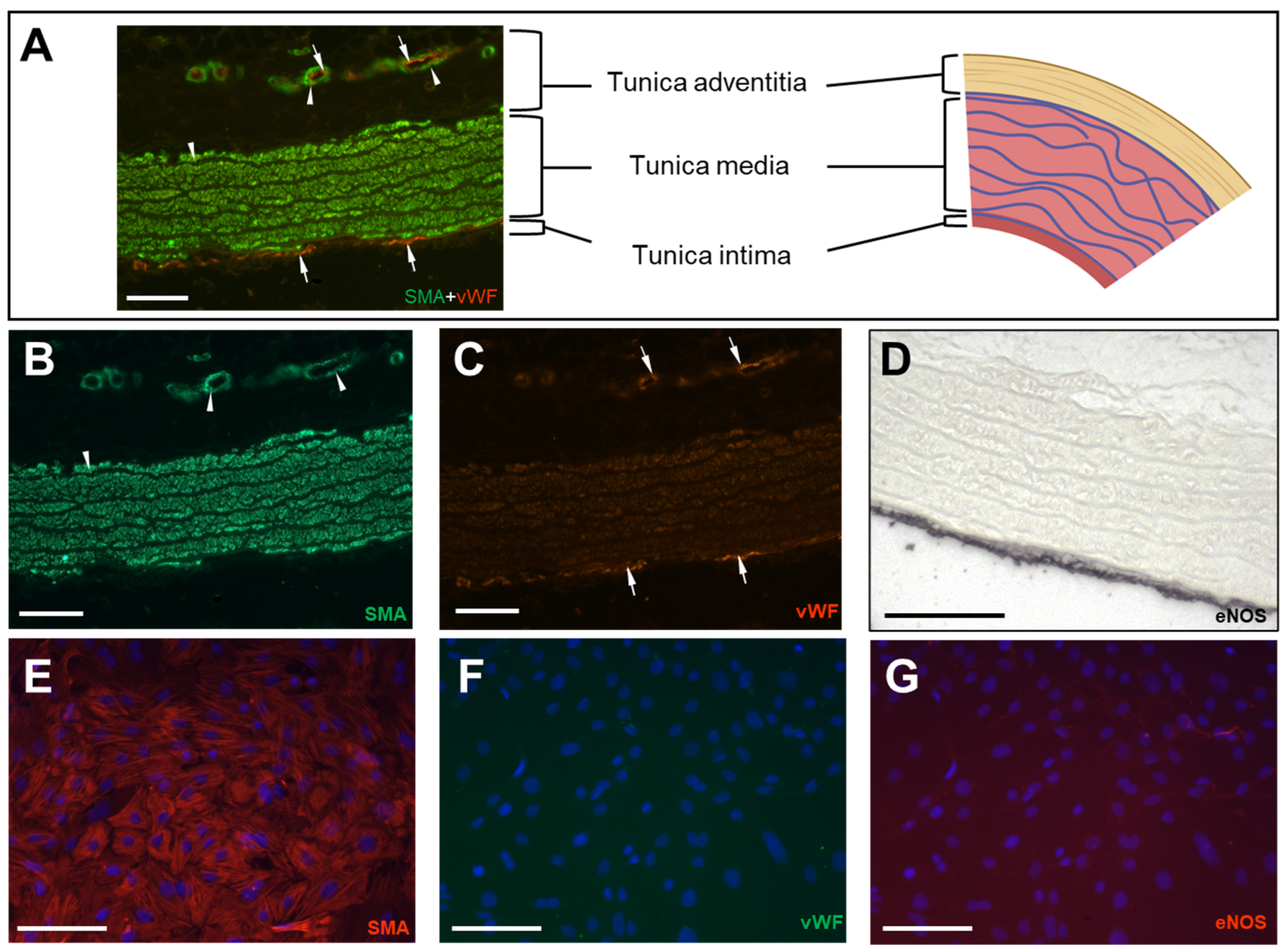
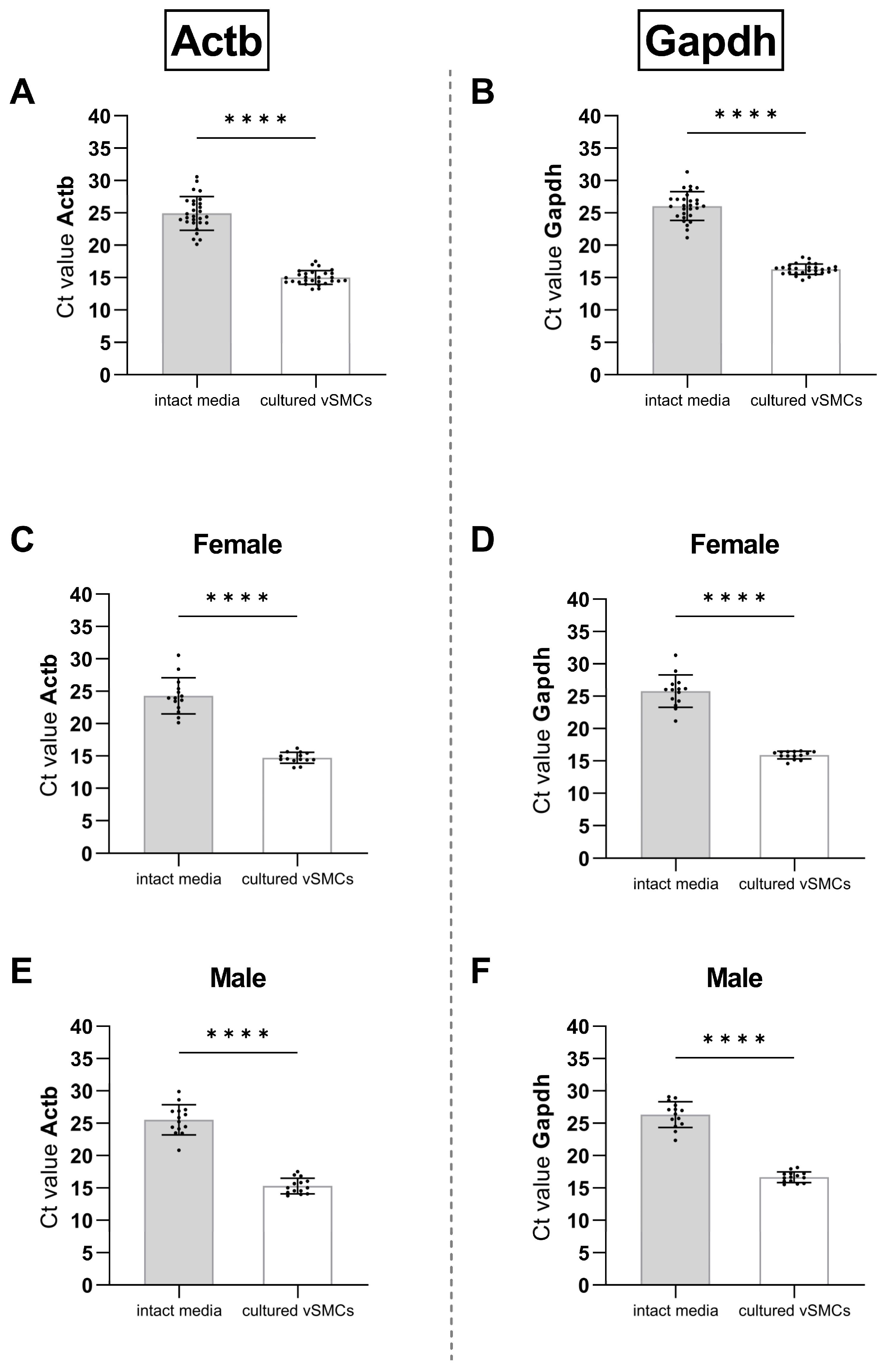
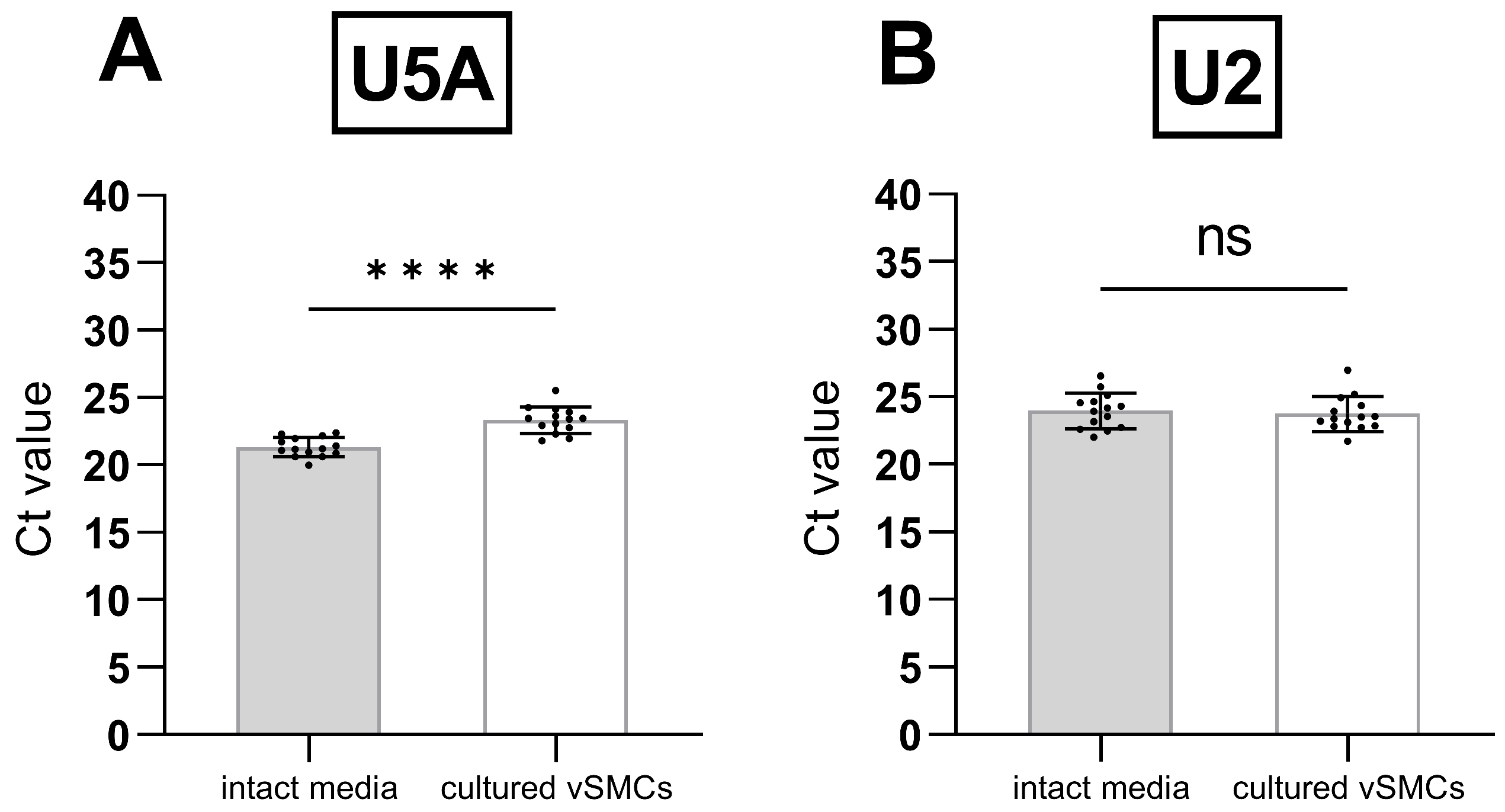
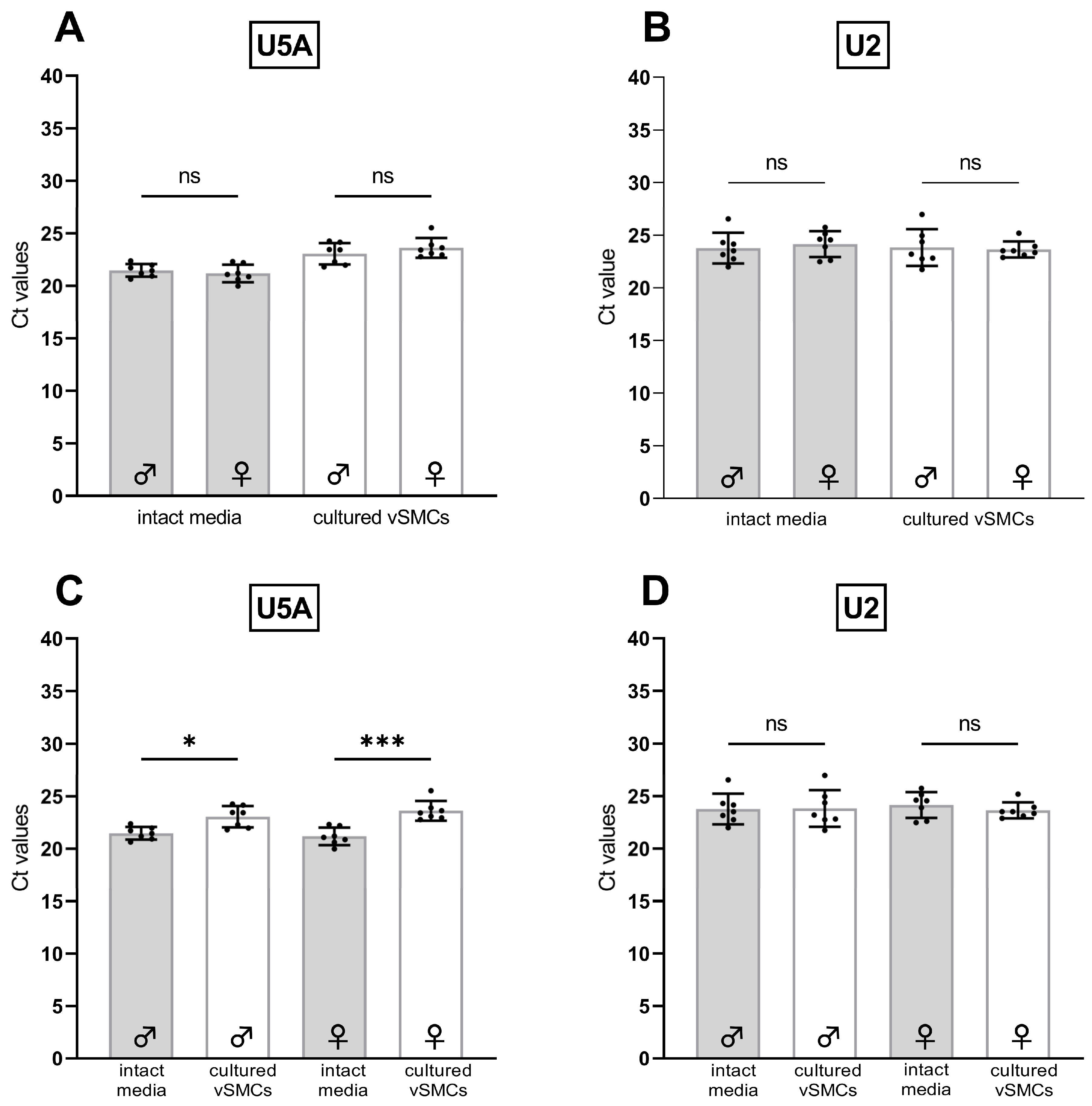
| Antibody | Host Antigen | Cat.no. | Clonality | Manufacturer | Dilution for Cells | Dilution for Tissue |
|---|---|---|---|---|---|---|
| anti-Calponin | rabbit | ab46794 | Mono | Abcam, Cambridge, UK | 1:500 | 1:500 |
| anti-SMA | mouse | A5228 | Mono | Sigma-Aldrich, St. Louis, MO, USA | 1:1000 | 1:1000 |
| anti-vWF | rabbit | AB7356 | Poly | Sigma-Aldrich, St. Louis, MO, USA | 1:500 | 1:1000 |
| anti-eNOS | mouse | 610297 | Mono | BDTrans, Franklin Lakes, NJ, USA | 1:500 | 1:200 |
| Antibody | Host Antigen | Cat.no. | Clonality | Manufacturer | Dilution for Cells | Dilution for Tissue |
|---|---|---|---|---|---|---|
| anti-rabbit Alexa488 | goat | A-11034 | Poly | Invitrogen, Waltham, MA, USA | 1:250 | 1:500 |
| anti-rabbit Cy3 | 111-166-045 | Poly | Jackson Immuno Research, Cambridgeshire, UK | |||
| anti-mouse Alexa488 | A-11001 | Poly | Invitrogen | |||
| anti-mouse Cy3 | 115-165-003 | Poly | Jackson Immuno Research |
| Step | Cycles | Duration | Temperature | |
|---|---|---|---|---|
| 1 | Polymerase activation | 1× | 3 min | 95 °C |
| 2 | Denaturation | 35× | 20 s | 95 °C |
| 3 | Primer hybridisation | 20 s | 60 °C | |
| 4 | Elongation | 20 s | 72 °C | |
| 5 | Melt curve analysis | 55–95 °C | ||
| Gene | Gene Group | Primer | |Ct intact media − Ct cultured vSMCs| | ||
|---|---|---|---|---|---|
| Total | Male | Female | |||
| Hypoxanthine phosphoribosyltransferase 1 | nucleotide synthesis | Hprt1_4 | 6.45 | 4.51 | 8.40 |
| Hprt1_B | 5.16 | 4.48 | 5.84 | ||
| Nucleoporin like 2 | protein export from nucleus | Nupl2_B | 6.29 | 7.48 | 5.48 |
| Tankyrase | protein stability and interaction | Tnks_T | 7.42 | 7.30 | 7.55 |
| Tnks_1 | 6.37 | 5.81 | 6.92 | ||
| TATA box binding protein | transcription | Tbp_T | 6.19 | 6.17 | 6.20 |
| Ribosomal protein L30 | protein synthesis | Rpl30_3 | 6.51 | 6.35 | 6.67 |
| Rpl30_1 | 5.55 | 5.78 | 5.83 | ||
| Ribosomal protein L32 | Rpl32_4 | 4.77 | 4.69 | 4.84 | |
| Rpl32_1 | 3.78 | 2.56 | 5.00 | ||
| Actin alpha 2, smooth muscle | cell structure and motility | Acta2_2 | 4.53 | 4.43 | 4.64 |
| Acta2_3 | 3.66 | 2.90 | 4.41 | ||
| Beta-2-microglobulin | serum protein | B2m_9 | 4.28 | 4.19 | 4.37 |
| B2m_T | 3.75 | 3.40 | 4.10 | ||
| Eukaryotic translation elongation factor 1 alpha 1 | translation | Eef1a1_T | 4.25 | 4.08 | 4.42 |
| Eukaryotic translation elongation factor 2 | Eef2_1 | 4.60 | 4.04 | 5.16 | |
| Eef2_2 | 4.58 | 4.39 | 4.76 | ||
| DNA topoisomerase 1 | DNA topology during transcription | Top1_B | 5.42 | 5.45 | 5.79 |
| Top1_1 | 3.66 | 3.49 | 3.84 | ||
| Small nucleolar RNA, C/D box 87 | methylation of preribosomal RNA precursors | Snord87_T | 2.92 | 3.22 | 2.66 |
| 5S ribosomal RNA | ribosomal RNAs | 5SrRNA_T | 2.37 | 2.07 | 2.33 |
| Small nuclear RNA U5A | splicing | U5A_T | 0.99 | 0.58 | 1.11 |
| Small nuclear RNA U2 | U2_T | 0.31 | 0.39 | 0.23 | |
Disclaimer/Publisher’s Note: The statements, opinions and data contained in all publications are solely those of the individual author(s) and contributor(s) and not of MDPI and/or the editor(s). MDPI and/or the editor(s) disclaim responsibility for any injury to people or property resulting from any ideas, methods, instructions or products referred to in the content. |
© 2023 by the authors. Licensee MDPI, Basel, Switzerland. This article is an open access article distributed under the terms and conditions of the Creative Commons Attribution (CC BY) license (https://creativecommons.org/licenses/by/4.0/).
Share and Cite
Rager, C.; Klöpper, T.; Pfeil, U.; Tasch, S.; Whittaker, M.R.; Exintaris, B.; Mietens, A.; Middendorff, R. Reference Gene U2 Enables Direct Comparison between Relative Gene Expression Levels of Vascular Smooth Muscle Cells in Tissue and Culture Using Real-Time Quantitative PCR. Cells 2023, 12, 2135. https://doi.org/10.3390/cells12172135
Rager C, Klöpper T, Pfeil U, Tasch S, Whittaker MR, Exintaris B, Mietens A, Middendorff R. Reference Gene U2 Enables Direct Comparison between Relative Gene Expression Levels of Vascular Smooth Muscle Cells in Tissue and Culture Using Real-Time Quantitative PCR. Cells. 2023; 12(17):2135. https://doi.org/10.3390/cells12172135
Chicago/Turabian StyleRager, Christine, Tobias Klöpper, Uwe Pfeil, Sabine Tasch, Michael Raymond Whittaker, Betty Exintaris, Andrea Mietens, and Ralf Middendorff. 2023. "Reference Gene U2 Enables Direct Comparison between Relative Gene Expression Levels of Vascular Smooth Muscle Cells in Tissue and Culture Using Real-Time Quantitative PCR" Cells 12, no. 17: 2135. https://doi.org/10.3390/cells12172135







